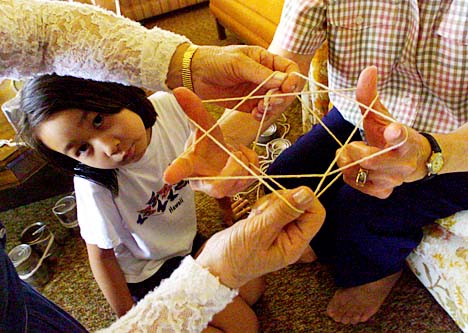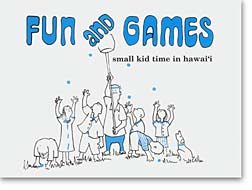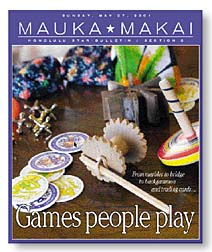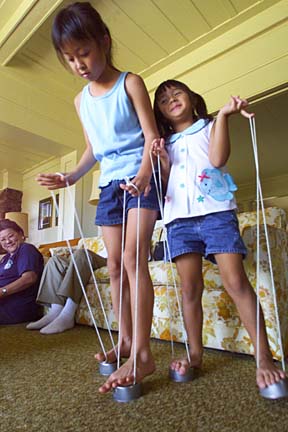

[ MAUKA-MAKAI ]

Not just In this corner of Hideto Kono's Manoa home, there's something of a circus going on. Kono is challenging Bernice Hirai to a duel, with blades of grass bent in the middle and pulled toward the challengers. Hers breaks and she shrieks, "I wasn't ready!"
‘Fun and Games’
Simple games played by our
elders brought people
closer togetherNadine Kam
Star-BulletinMake that best two out of three?
In that corner, Dorothy Hazama is tossing bean bags into the air -- one, two, three -- talking all the while. "I used to be able to do this all kind ways, juggling behind my back, under my legs.
"Sixty years ago we used to do this and it helped us with our coordination. We weren't sitting and watching TV all the time."
"There was no TV," calls Hirai, laughing and intent on beating Kono.
Hazama laughs, a beanbag finally escaping and hitting her -- plop! -- square on the eye.

On this afternoon, the group of seniors from the Hawai'i Hiroshima Heritage Study Group were sharing some of their childhood games with their grandchildren. But would kids who grew up with Nintendo, PlayStation and Rollerblades find happiness in a handful of weeds, some old tin cans and tree branches?
"Fun and Games: Small Kid Time in Hawai'i," ON THE SHELF
Hawai'i Hiroshima Heritage Study GroupTo buy: Pick up copies at the Japanese Cultural Center of Hawaii, 2454 S. Beretania St., or send check or money order for $12.95 to H3SG, P.O. Box 75436, Honolulu, HI 96836. For one or two books add $4 for shipping and handling. For three to five books, add $5.50.
For one afternoon at least, it seemed the answer was yes. Jena Hayama, 8, and her 5-year-old sister Katie, were walking on the empty cans-turned-stilts thanks to lengths of string that allowed them to pull up on the upturned cans with each step. Kristen Hazama was learning to blow dishwater soap bubbles through the stalk of a papaya leaf. Kyle Hayama, 8, had passed on the opportunity to play a solo game of "NBA Live" on PlayStation to outshoot Kono with a homemade slingshot. And it was tough to tell who was more competitive, the kids or adults, when it came to the "fight grass" game known as kiri kiri, played with the thin stalks of the flowering nutgrass.
With a little imagination, any object can be transformed into a source of joy and entertainment, and that is the wisdom of H3SG's book, "Fun and Games: Small Kid Time in Hawaii." Former Gov. George Ariyoshi, who grew up in the '30s and '40s in Honolulu and Windward Oahu, contributed the foreword.
The H3SG came together in 1986 during Hawaii's Japanese Centennial activities to study their genealogy. After fleshing out their family histories, Hirai said, "We realized we were the last generation that had any connection to the issei (the first generation of immigrants to Hawaii).
"Now the sansei and yonsei (third and fourth generations) perform the wedding rituals, the yakudoshi, but they don't know the meanings. We realized that this generation, if we don't write down the meanings, our grandchildren will be lost."
For this reason, the H3SG group -- primarily nisei, with a few sansei -- has stuck together, partnering on projects to preserve the legacy handed down to them by their parents.
Although latch-key children are believed to be a late 20th-century development born of the women's rights movement, members of the H3SG group were no strangers to this phenomenon. Their parents worked, often for low pay, leaving them to entertain themselves.
"We had a lot of freedom," Kono said. "There was time to get together and play. We learned social responsibility that way too. No one cheated because we lived so close together we had to be honest.
"Now I see our grandchildren are pretty well-scheduled. Every afternoon they're going out for soccer or basketball and their parents are chauffeuring them to gyms or rec centers. There's very little time for kids to do independent things.

"With people moving into condos, children don't always have the outdoor facilities where it's safe for play. A lot of factors mitigate against children getting together."The result, he said, contributes to a society where people don't know their neighbors and don't feel connected to the community.
Although there's a tendency to look at play as meaningless activity, play reinforces the rules of society. The playground is where future leaders first feel the rush of power and influence as they play general to others' good soldiers, or where nurturing types form families around dolls, mud pies and tea parties.
Parents or guardians lecture, "play fair, play by the rules," implying that to do otherwise would end in someone getting hurt.
It's hard to imagine exercising the same consideration when playing against a computer that doesn't cry, whine or sulk. It won't slug you in the arm, call you a liar or cheat, or accuse you of changing the rules. On that kind of playing field, anything goes and the human mind can get skewed into believing winning is everything.
Besides, a computer game has little to teach about the world, or offer much in the way of memories. How can winning at Super Mario compare to the thrill of plucking wasps out of a swarm, as Kono and his friends did?
"We know the male wasps don't sting, and if you looked carefully, you could tell the males from the females," he said. "But the girls don't know that, so we would catch the wasps with our hands and that impressed them."
"Oh, you thought so!," said Hirai.
Kono also talked about using his slingshot on cardinals that dared to raid his family's mountain apple tree.
"Now I'm philosophical," he said. "The birds only took enough for themselves. If anything, it's the humans who take more than their share."
The slingshot was just one of the toys the kids made themselves. Chapters 3 and 4 of "Fun and Games" focuses on the how-tos of constructing toys such as a pea-shooting clothespin gun, wooden boat, or top made from the eucalyptus pod. The descriptions are accompanied by illustrations by H3SG chairman Carl Kaizawa.

Motoyoshi Tanaka of Hilo wrote of setting cardboard boxes adrift on Wailoa River with a cargo of firecrackers, connected to a fuse he and his friends could light from a safe vantage. Banana trunk rafts were sunk the same way. Every generation has its fascination with explosions, after all.There were also fond memories of Bull Durham tobacco bags that were stuffed and used as a ball to play alavia, a kinder, gentler form of dodgeball, and in theory, today's paintball. The bags were filled with green grass shavings and seeds so as not to injure anyone who was struck.
Girls and boys tended to play different games, although a few, like marbles and jacks were unisex. And beyond what the kids could amass from nature and recycle from the family trash, there were a few store-bought treasures such as Shirley Temple and Betty Boop dolls. Hirai and Ethel Hazama Yamane kept their dolls for more than 60 years.
"Our dolls were precious to us," Hirai said. "Today youngsters get new things and play with them for such a short time before they get bored with it, the toys someone spent so much on."
Just then Kono came back into the house, his competitive nature squelched for the moment.
"I was trying to impress my grandson by showing him how far and accurately I could shoot a slingshot. I told him I was going to shoot 20 feet and it only went 5 feet. How embarrassing!
"I used to be able to shoot 25 feet. See, you have to recognize the trajectory. You don't shoot right at the target, but over it. I used to be quite accurate."
His grandson Kyle seemed relieved. Asked whether he would have been able to beat his grandfather if they were the same age, his answer was a quick, emphatic, "No."
Click for online
calendars and events.